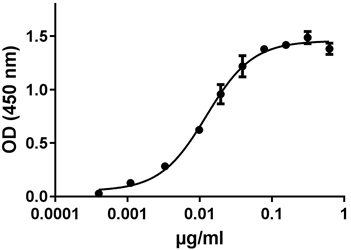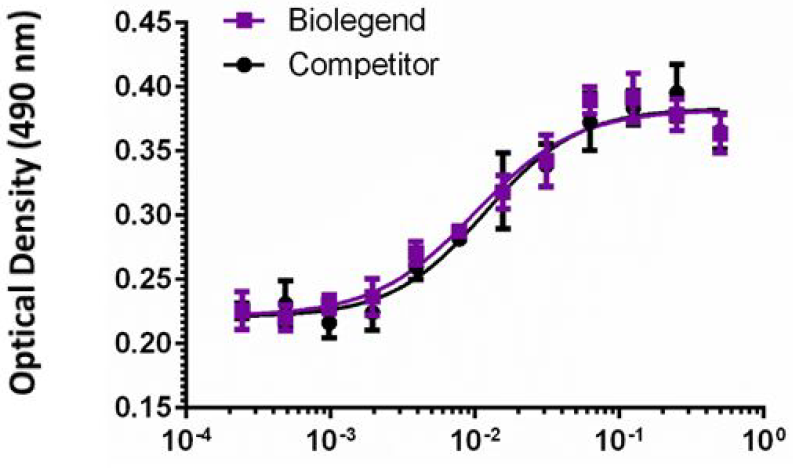- Regulatory Status
- RUO
- Other Names
- Keratinocyte growth factor, Fibroblast growth factor 7 (FGF-7), HBGF-7, FGF7, HBGF7
- Ave. Rating
- Submit a Review
- Product Citations
- publications
_Mouse_RECOM_CA_BA_070115.JPG&Width=240&Height=300&altFmImage_path=&Compression=90&Crop=5)
-
MCF-7 cell proliferation induced by mouse KGF in the presence of 10 µg/mL heparin. -

Mouse KGF (FGF-7) induces proliferation of human mammary gland MCF-7 cells in the presence of 10 μg/mL heparin, in a dose-dependent manner. BioLegend’s mouse KGF product was compared side-by-side to a competitor’s equivalent product.
KGF is a heparin binding growth factor secreted by cells of mesenchymal origin. KGF acts in a paracrine manner by binding exclusively to a splice variant of FGF receptor 2, FGFR2-IIIB, receptor which is predominantly expressed by epithelial cells. This suggests that KGF may play an important role in mesenchymal-epithelial communication. KGF stimulates proliferation, migration, and differentiation of epithelial cells in a variety of tissues. In skin, KGF is strongly upregulated in dermal fibroblasts after skin injury. Also, it induces keratinocyte proliferation and migration and it protects epithelial cells from reactive oxygen species. In the liver, KGF is required for adult liver regeneration. While in the brain, KGF is important for inhibitory synapse formation in the hippocampus. KGF-deficient mice are prone to epileptic seizures induced by chemical kindling in adults. KGF signaling is also important for hair follicle development. The injection of recombinant KGF into adult, athymic nude mice can induce dose-dependent hair growth. In the thymus, KGF improves postnatal T-cell development through improvements in proliferation and function of thymic epithelial cells. In the lungs, KGF can protect animals from oxidant-induced injuries. Taken together, KGF is a potential target for epithelial tissue repair.
Product DetailsProduct Details
- Source
- Mouse KGF, amino acids Cys32-Thr194 (Accession# BC052847.1), was expressed in E. coli.
- Molecular Mass
- The 163 amino acid recombinant protein has a predicted molecular mass of approximately 18.7 kD. The protein migrates at approximately 21 kD in DTT-reducing conditions and non-reducing conditions by SDS-PAGE. The predicted N-terminal amino acid is Cys.
- Purity
- >95%, as determined by Coomassie stained SDS-PAGE.
- Formulation
- Sterile-filtered with 0.2 µm filter, solution is comprised of 10 mM MOPS, 50 mM Na2SO4, 0.5 mM EDTA, and 0.5 mM DTT in pH 7.2.
- Endotoxin Level
- Less than 0.01 ng per µg cytokine as determined by the LAL method.
- Concentration
- 10 and 25 µg sizes are bottled at 200 µg/mL. 100 µg size and larger sizes are lot-specific and bottled at the concentration indicated on the vial. To obtain lot-specific concentration and expiration, please enter the lot number in our Certificate of Analysis online tool.
- Storage & Handling
- Unopened vial can be stored between 2°C and 8°C for up to 2 weeks, at -20°C for up to six months, or at -70°C or colder until the expiration date. For maximum results, quick spin vial prior to opening. The protein can be aliquoted and stored at -20°C or colder. Stock solutions can also be prepared at 50 - 100 µg/mL in appropriate sterile buffer, carrier protein such as 0.2 - 1% BSA or HSA can be added when preparing the stock solution. Aliquots can be stored between 2°C and 8°C for up to one week and stored at -20°C or colder for up to 3 months. Avoid repeated freeze/thaw cycles.
- Activity
- The ED50 is 0.1 - 0.5 ng/ml, corresponding to a specific activity of 0.2 - 1 x 107 units/mg, as determined by a dose-dependent MCF-7 cell proliferation in the presence of 10 µg/ml heparin. The proliferation was measured by the colorimetric MTS assay.
- Application
-
Bioassay
- Application Notes
-
BioLegend carrier-free recombinant proteins provided in liquid format are shipped on blue-ice. Our comparison testing data indicates that when handled and stored as recommended, the liquid format has equal or better stability and shelf-life compared to commercially available lyophilized proteins after reconstitution. Our liquid proteins are verified in-house to maintain activity after shipping on blue ice and are backed by our 100% satisfaction guarantee. If you have any concerns, contact us at tech@biolegend.com.
Antigen Details
- Structure
- Growth factor.
- Distribution
-
KGF is widely expressed among cells of mesenchymal origin.
- Function
- KGF is secreted by fibroblasts and can stimulate the proliferation of epithelial cells. KGF expression can be highly upregulated in various tissues after injury.
- Interaction
- Epithelial cells.
- Ligand/Receptor
- FGF-7 receptor (FGFR2/IIIb).
- Cell Type
- Embryonic Stem Cells
- Biology Area
- Cell Proliferation and Viability, Stem Cells
- Molecular Family
- Cytokines/Chemokines, Growth Factors
- Antigen References
-
1. Werner S, et al. 1998. Cytokine Growth Factor Rev. 9:153.
2. Werner S, et al. 1994. Science 266:819.
3. Rossi SW, et al. 2007. Blood 109:3803.
4. Yen TT, et al. 2014. Protein Pept. Lett. 21:306.
5. Hsu YR, et al. 1999. Biochemistry 38:2523. - Gene ID
- 14178 View all products for this Gene ID
- UniProt
- View information about KGF on UniProt.org
Related FAQs
- Why choose BioLegend recombinant proteins?
-
• Each lot of product is quality-tested for bioactivity as indicated on the data sheet.
• Greater than 95% Purity or higher, tested on every lot of product.
• 100% Satisfaction Guarantee for quality performance, stability, and consistency.
• Ready-to-use liquid format saves time and reduces challenges associated with reconstitution.
• Bulk and customization available. Contact us.
• Learn more about our Recombinant Proteins. - How does the activity of your recombinant proteins compare to competitors?
-
We quality control each and every lot of recombinant protein. Not only do we check its bioactivity, but we also compare it against other commercially available recombinant proteins. We make sure each recombinant protein’s activity is at least as good as or better than the competition’s. In order to provide you with the best possible product, we ensure that our testing process is rigorous and thorough. If you’re curious and eager to make the switch to BioLegend recombinants, contact your sales representative today!
- What is the specific activity or ED50 of my recombinant protein?
-
The specific activity range of the protein is indicated on the product datasheets. Because the exact activity values on a per unit basis can largely fluctuate depending on a number of factors, including the nature of the assay, cell density, age of cells/passage number, culture media used, and end user technique, the specific activity is best defined as a range and we guarantee the specific activity of all our lots will be within the range indicated on the datasheet. Please note this only applies to recombinants labeled for use in bioassays. ELISA standard recombinant proteins are not recommended for bioassay usage as they are not tested for these applications.
- Have your recombinants been tested for stability?
-
Our testing shows that the recombinant proteins are able to withstand room temperature for a week without losing activity. In addition the recombinant proteins were also found to withstand four cycles of freeze and thaw without losing activity.
- Does specific activity of a recombinant protein vary between lots?
-
Specific activity will vary for each lot and for the type of experiment that is done to validate it, but all passed lots will have activity within the established ED50 range for the product and we guarantee that our products will have lot-to-lot consistency. Please conduct an experiment-specific validation to find the optimal ED50 for your system.
- How do you convert activity as an ED50 in ng/ml to a specific activity in Units/mg?
-
Use formula Specific activity (Units/mg) = 10^6/ ED50 (ng/mL)
 Login / Register
Login / Register 



_Mouse_RECOM_CA_BA_070115.JPG&Height=80&altFmImage_path=&Compression=90&Crop=5)









Follow Us